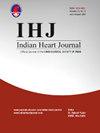混合冠状动脉血管重建术与传统冠状动脉搭桥手术在现实世界中对多支冠状动脉疾病患者的比较:住院结果和中期随访
IF 1.4
Q3 CARDIAC & CARDIOVASCULAR SYSTEMS
引用次数: 0
摘要
目的:本观察性研究的目的是评估混合冠状动脉血管重建术(HCR)与传统冠状动脉旁路移植术(CABG)在现实世界中的住院和中期结果。方法:对2018年1月至2021年1月期间在我院接受常规冠脉搭桥和HCR治疗的所有多支冠状动脉疾病(MV-CAD)患者的重症监护病房(ICU)时间、住院时间、重复血运重建率、出血、卒中和院内死亡率进行评估。临床结果(死亡率和主要心脑血管不良事件[MACCE])在平均3.6年的随访中进行评估。结果:倾向评分匹配后,各组间手术前特征趋于平衡。MACCE无显著差异[优势比:0.57;95% CI: 0.05 ~ 1.52;P =0.66],住院死亡率[n=2 (1.9%) vs n=0;P =0.80],手术后卒中[n=2 (1.9%) vs n=2 (3.7%);P =0.86],术后需要重复血运重建术的心肌梗死[n=2(1.9%)对n=1 (1.9%);P =1]。HCR与输血需求、出血风险、住院时间和重症监护病房时间显著降低相关。3.6年后的结果分析显示MACCE无显著差异[优势比:1.40;95% CI: 0.46 ~ 4.30;P =0.55],出院后死亡率[n=0 vs n=0;p = 1]。两组术后需要重复血运重建术的心肌梗死发生率相似[n=0 vs n=4 (7.4%);P =0.278],再干预率[n=0 vs n=3] (5.6%);p = 0.41)。结论:HCR可被认为是一种安全可行的替代传统冠脉搭桥的方法,适用于特定的MV-CAD患者。本文章由计算机程序翻译,如有差异,请以英文原文为准。
Comparison of hybrid coronary revascularization versus conventional Coronary Artery Bypass surgery in patients with multi-vessel coronary artery disease in a real-world setting: In-hospital outcomes and medium-term follow-up: COHOS study
Objectives
The aim of this observational study was to evaluate the in-hospital and medium-term outcomes of hybrid coronary revascularization (HCR) in the real-world setting compared to conventional coronary artery bypass grafting (CABG).
Methods
All patients with multi-vessel coronary artery disease (MV-CAD) who underwent conventional CABG and HCR in our institution between January 2018 to January 2021 were evaluated in terms of length of intensive care unit (ICU), in-hospital stay, repeat revascularization rates, bleeding, stroke, and in-hospital mortality. Clinical outcomes (mortality and major adverse cardiac and cerebrovascular events [MACCE]) were assessed at average follow up of 3.6 years.
Results
Pre-procedural characteristics were balanced between the groups after propensity score matching. There was no significant difference in MACCE [Odds ratio: 0.57; 95 % CI: 0.05 to 1.52; p = 0.66], in-hospital mortality [n = 2 (1.9 %) vs n = 0; p = 0.80], post procedure stroke [n = 2 (1.9 %) vs n = 2 (3.7 %); p = 0.86], post-procedural myocardial infarction requiring repeat revascularization [n = 2 (1.9 %) versus n = 1 (1.9 %); p = 1] during the in-hospital stay of the patients in the CABG vs HCR groups respectively. HCR was associated with significantly lower requirement for blood transfusions, bleeding risk, in-hospital stay, and intensive care unit stay. Analysis of the outcomes after 3.6 years revealed no significant difference in MACCE [Odds ratio: 1.40; 95 % CI: 0.46 to 4.30; p = 0.55], and post discharge mortality [n = 0 vs n = 0; p = 1]. Both groups had similar rates of post-procedural myocardial infarction requiring repeat revascularization [n = 0 vs n = 4 (7.4 %); p = 0.278], and rate of re-intervention [n = 0 vs n = 3 (5.6 %); p = 0.41].
Conclusion
HCR may be considered as a safe and feasible alternative to conventional CABG in selected individuals with MV-CAD.
求助全文
通过发布文献求助,成功后即可免费获取论文全文。
去求助
来源期刊

Indian heart journal
CARDIAC & CARDIOVASCULAR SYSTEMS-
CiteScore
2.60
自引率
6.70%
发文量
82
审稿时长
52 days
期刊介绍:
Indian Heart Journal (IHJ) is the official peer-reviewed open access journal of Cardiological Society of India and accepts articles for publication from across the globe. The journal aims to promote high quality research and serve as a platform for dissemination of scientific information in cardiology with particular focus on South Asia. The journal aims to publish cutting edge research in the field of clinical as well as non-clinical cardiology - including cardiovascular medicine and surgery. Some of the topics covered are Heart Failure, Coronary Artery Disease, Hypertension, Interventional Cardiology, Cardiac Surgery, Valvular Heart Disease, Pulmonary Hypertension and Infective Endocarditis. IHJ open access invites original research articles, research briefs, perspective, case reports, case vignette, cardiovascular images, cardiovascular graphics, research letters, correspondence, reader forum, and interesting photographs, for publication. IHJ open access also publishes theme-based special issues and abstracts of papers presented at the annual conference of the Cardiological Society of India.
 求助内容:
求助内容: 应助结果提醒方式:
应助结果提醒方式:


